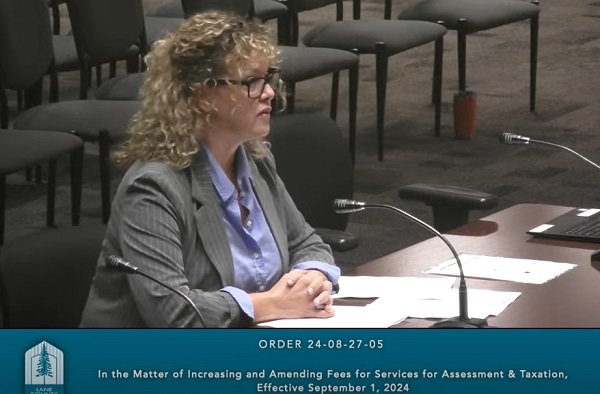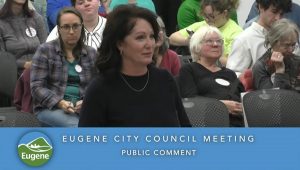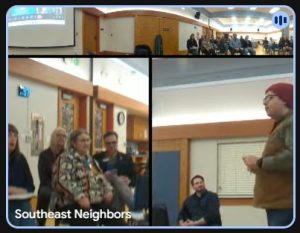Pat Farr leads the questioning on county fee hikes
4 min read
[00:00:00] John Q: Commissioner Pat Farr led the questioning as the Lane County assessor explained the need for higher fees. On Aug. 27:
[00:00:08] Lane County Assessor Mary Vuksich-Shafer: Today I’m here to talk about the matter of increasing and amending fees for services for Assessment and Taxation (A&T).
[00:00:16] The purpose of Assessment and Taxation is to appraise property, to calculate, collect, and distribute taxes, and to provide related information to the public in a manner that merits the highest degree of confidence in our integrity, efficiency, and fairness.
[00:00:31] We are a broad service organization mandated by the Oregon Constitution and Oregon law and collect revenue for 85 taxing jurisdictions, including local governments, schools, and special districts that provide the essential public services for the citizens of Lane County.
[00:00:50] For the 23-24 tax year, we certified a real market value of $97.8 billion, a taxable value of $41.1 billion. We certified $695.8 million in certified taxes. $51 million of that was earmarked for the Lane County general fund. In November of 2023 alone, we collected and distributed over $631 million to the districts.
[00:01:20] We also supported the administration and creation of two new taxing districts, Row River Rural Fire Protection District, and Pleasant Hill / Goshen.
[00:01:31] Pat Farr (Lane County commissioner): $631 million a year distributed to the districts throughout the county. How much do they pay your office for that?
[00:01:38] Mary Vuksich-Shafer: They don’t pay an administrative fee at all.
[00:01:40] Pat Farr: You’re kidding. So, your office absorbs the fee out of your ever-decreasing general fund contribution, and your-ever decreasing staffing levels, absorbing all of the taxing workload for the entire county. And then you bring it in and then you write them a check and send it to them. Can I get in on that? (laughter)
That is, you know, it’s something that people don’t really fully understand about your office. (Right.) And about taxation. (Yeah.) They think that everything comes to the county and that you’re the holder of the treasury. But you are merely the distributor, the passer-along.
[00:02:11] Mary Vuksich-Shafer: Right. Yes. Thank you, Commissioner. We appraise, value, collect, and distribute, and we do it on behalf of the 85 taxing districts that we serve, and the only district that pays for our services is the county.
[00:02:26] Pat Farr: And how much of that 100% percent do we get (the county)? I know the answer.
[00:02:31] Mary Vuksich-Shafer: Well, it depends on the year, but generally between 11 and 12 cents a dollar.
[00:02:36] Pat Farr: Yeah, about a dime on the dollar. (Yeah.) A little over a dime on the dollar is what we get at Lane County. (Correct.) Everybody else gets it, that’s just a part of the service that Lane County provides. (That’s correct.) And they expect we provide it.
[00:02:46] But that’s something that people don’t fully grasp, is, you know, when they write a check to Lane County, my check is written to Lane County. ‘Well, look at all that money I’m giving Lane County.’ But 90% of that, close to 90% is going to school districts, fire districts, cities, etc. (Correct.) And that’s right. That is the way it should be. I’m not faulting that, but it’s something that people don’t fully understand.
[00:03:06] And you absorb changes that come from above. For instance, I was on the school board back in the early 1990s when Measure 5 was passed. What an incredible impact that had on taxation at the county level. (Mm-hmm.) You absorbed it. A little before your time.
[00:03:20] Mary Vuksich-Shafer: I was a little girl when Measure 5 passed and I lived out River Road with my parents and my mom was a teacher at the time. And I remember my dad voted in favor of (Sorry Dad!) of Measure 5 and he has since regretted that vote.
[00:03:34] And my mom sent me outside because my parents were going to have a conversation about why he voted for that. So, here we are all these years later and I think about that story and I think, ‘Oh boy, here I am, talking about Measure 5. Still.’
[00:03:50] John Q: She explained why the county needs to increase fees.
[00:03:56] Mary Vuksich-Shafer: So why am I here today? Expenses have been rising due to various factors:
- Increased administrative workload: The volume and complexity of tax exemption programs has grown, requiring more staff time with a higher level of expertise;
- Technological maintenance: Maintaining our technology systems to meet the ever-increasing unfunded mandates set forth by statutes, administrative rules, and the Department of Revenue;
- Regulatory changes: Adapting to new statutes and administrative rules to ensure compliance involves additional resources and expertise; (And lastly, and probably most importantly, is)
- Fewer full time employees: (Assessment and Taxation) A&T’s primary source of funding is the county general fund and a shrinking grant from the Oregon Department of Revenue.
[00:04:44] A study conducted by the Department of Revenue recommended staffing levels for a county the size of Lane with approximately 190,000 tax accounts was 74 full-time employees. For fiscal year 24-25, A&T’s approved budget included 48 full-time employees, a reduction of one from the previous year. We are asked to do more with less.
[00:05:08] Over 30,000 accounts in Lane County have property tax exemption or special assessments for a taxable value just over $3.2 billion. We administer over 120 different exemption programs. One particular program is not the same as the next. So there’s 120 different variations of programs that we administer.
[00:05:29] So our level of expertise has to meet, and we have to understand, all the criteria involved in each different exemption program of those 120 programs. So the fees really cover that cost and that expertise. The fees would also cover more training with the Department of Revenue. Those trainings are not free to us.
[00:05:51] So to address these challenges, the amended and new fees will allow A&T to recover a portion of the costs associated with providing the related services.
[00:06:00] John Q: Higher fees for some tax exemption programs go into effect Sept. 1.



